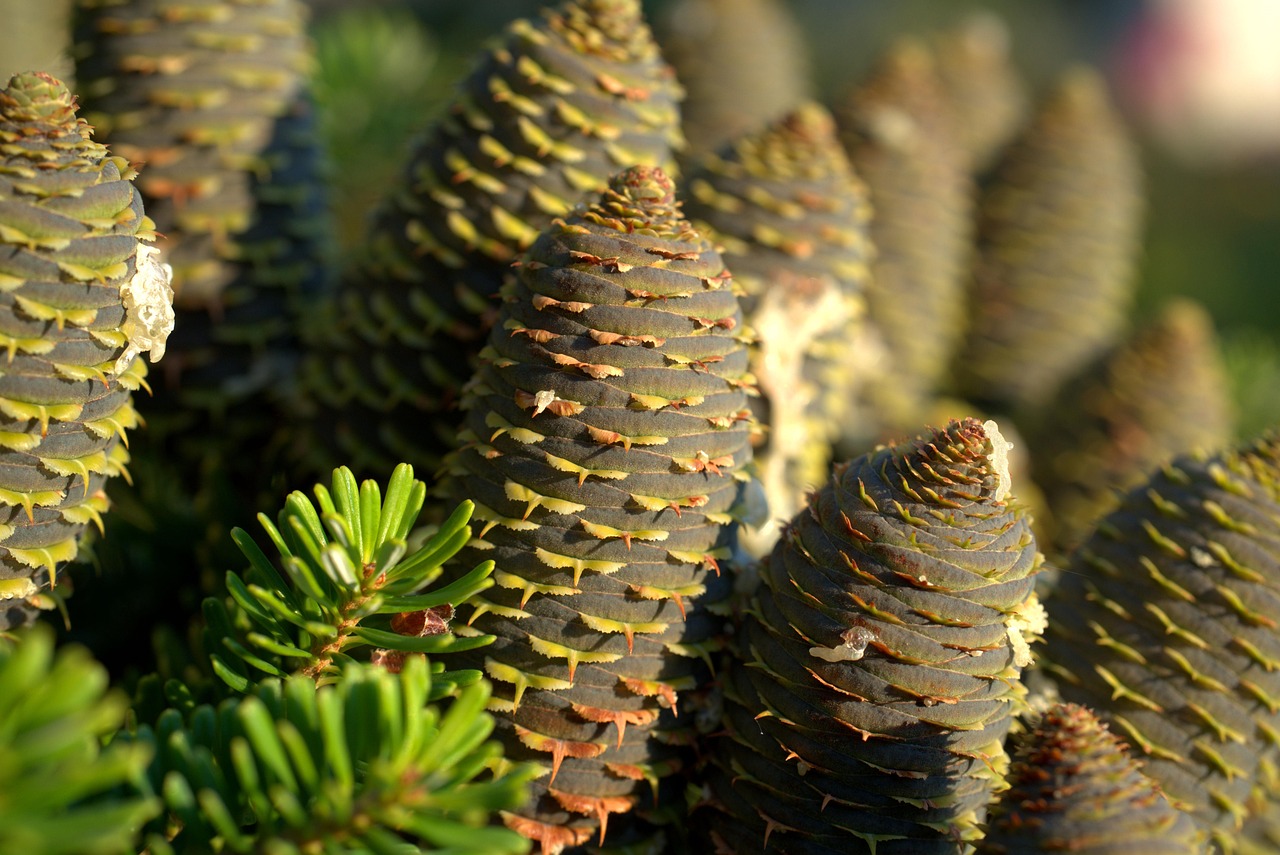White spruce trees (Picea glauca) exhibit a moderate growth rate in northern regions, typically ranging from 12 to 24 inches per year under optimal conditions. Factors such as soil quality, moisture availability, and temperature significantly influence their growth. These trees thrive in well-drained soils and can adapt to various climates, making them a resilient choice for reforestation efforts.
The White Spruce tree (Picea glauca) typically grows at a rate of 12 to 24 inches per year in northern regions, depending on environmental conditions such as soil quality, moisture, and climate.
The White Spruce is a native tree species found in the northern parts of North America. It is well-adapted to cold climates and is commonly used in forestry and landscaping. Known for its straight trunk and conical shape, the White Spruce can reach heights of up to 60 feet and can live for over a century. The tree is particularly valued for its wood, which is used in construction, paper production, and various crafts.

Understanding the growth rate of the White Spruce is crucial for ecological studies and forestry management. Growth rates can vary significantly based on several factors. These include soil type, weather conditions, and the tree’s age. In northern regions, where the climate is harsher, the growth rate may differ from that in milder areas.
Factors Affecting Growth Rate
Several factors influence the growth rate of the White Spruce. Here are some of the most significant:
- Soil Quality: Rich, well-drained soils promote better growth. Compacted or poor-quality soils can hinder development.
- Moisture Availability: Adequate rainfall or irrigation is essential. Drought conditions can slow growth significantly.
- Temperature: Cooler temperatures in northern regions can limit the growing season, affecting overall height increase.
- Light Exposure: Full sunlight encourages faster growth. Trees growing in shaded areas may grow more slowly.
- Pests and Diseases: Infestations or infections can weaken trees and reduce their growth rates.
Growth Stages
The growth of a White Spruce can be divided into several stages:

- Seedling Stage: This initial stage lasts from germination until the tree reaches about 1 foot in height. Growth during this phase is slow and vulnerable to environmental stresses.
- Young Tree Stage: From 1 to 10 years, the tree begins to establish itself. Growth rates increase as it adapts to its environment.
- Mature Tree Stage: After 10 years, a White Spruce can grow more rapidly, reaching its maximum height. This stage can last several decades.
- Old Age Stage: As the tree ages beyond 50 years, growth slows again. The focus shifts more towards reproduction than vertical growth.
Growth Rate Data
The following table summarizes the average growth rates of White Spruce trees at different ages in northern regions:
| Age (Years) | Average Height (Feet) | Growth Rate (Inches/Year) |
|---|---|---|
| 1 | 1 | 6-12 |
| 5 | 5-10 | 10-18 |
| 10 | 15-20 | 12-24 |
| 20 | 30-40 | 12-24 |
| 50+ | 50-60 | 6-12 |
The data shows how growth rates change as the tree matures. Young trees tend to grow faster than older ones. This pattern highlights the importance of understanding how age affects growth for effective forest management.
Additionally, White Spruce is often planted in reforestation efforts due to its adaptability and rapid initial growth. Forest managers consider these growth rates when selecting species for specific sites. Proper planning can lead to healthier forests that support biodiversity and provide economic benefits.

By monitoring these factors and understanding how they interplay with growth rates, foresters can make informed decisions that ensure sustainable management of White Spruce populations in northern regions.
Environmental Adaptations of White Spruce
The White Spruce tree has developed several adaptations that allow it to thrive in the harsh conditions of northern regions. Understanding these adaptations is essential for appreciating how this species grows and survives in its native habitat.
Cold Resistance
White Spruce trees can endure extremely low temperatures. Their needle-like leaves reduce water loss and prevent damage from frost. Additionally, the tree’s internal structure is designed to withstand freezing temperatures, allowing it to survive in climates where other species may fail.

Soil Adaptability
This tree species is versatile regarding soil types. It can grow in various soil conditions, from sandy to rocky terrains, as long as there is sufficient drainage. The roots of the White Spruce can penetrate deeply, allowing the tree to access moisture and nutrients that are otherwise unavailable.
Water Efficiency
White Spruce has evolved mechanisms to conserve water. During dry spells, the tree can slow its growth and reduce transpiration rates. This ability to adapt to varying moisture levels is crucial for survival in northern regions, where droughts can occur.
Impact of Climate Change on Growth Rates
Climate change poses significant challenges to White Spruce growth rates. As temperatures rise and weather patterns shift, the growth dynamics of this species may change. Here are some key impacts:
- Temperature Increases: Warmer temperatures could lengthen the growing season but may also lead to stress during extreme heat events.
- Altered Precipitation Patterns: Changes in rainfall can lead to both drought conditions and flooding, affecting the tree’s health and growth.
- Pest Infestations: Warmer winters may allow pests that previously could not survive the cold to thrive, leading to increased infestations that can harm growth.
- Soil Degradation: Changes in temperature and moisture can affect soil quality, impacting nutrient availability and root development.
White Spruce in Forest Ecosystems
The White Spruce plays a vital role in forest ecosystems. It provides habitat and food for various wildlife species. Its presence influences the overall health of the forest. Here are some key ecological roles of White Spruce:
- Habitat Provider: White Spruce stands offer shelter for birds, mammals, and insects. Many species depend on these trees for nesting and feeding.
- Soil Stabilization: The root systems of these trees help prevent soil erosion. This stabilization is crucial in maintaining healthy forest ecosystems.
- Nutrient Cycling: As White Spruce trees shed needles and branches, they contribute organic matter to the soil. This process enriches the soil and promotes biodiversity.
- Carbon Sequestration: Like all trees, White Spruce absorbs carbon dioxide from the atmosphere. This function helps mitigate climate change by reducing greenhouse gas concentrations.
Commercial Uses of White Spruce
The wood of the White Spruce is highly valued in various industries. Its properties make it suitable for several applications:
- Construction: The light yet strong wood is commonly used for framing and structural components.
- Pulp and Paper Production: White Spruce wood is an excellent source for making high-quality paper products.
- Musical Instruments: The wood’s acoustic properties make it a popular choice for crafting instruments such as pianos and guitars.
- Furniture Making: Its fine grain and light color are appealing for furniture design, providing aesthetic value.
Challenges Facing White Spruce
Despite its adaptability, White Spruce faces numerous challenges that can impact its growth rates and overall health. Some of these challenges include:
- Disease: Fungal infections can affect the health of the tree, leading to reduced growth or mortality.
- Pests: Insects such as bark beetles can cause significant damage to the tree’s structure.
- Climate Change Effects: As mentioned earlier, changing climate conditions can impact growth rates adversely.
- Human Activity: Urbanization and land-use changes can lead to habitat loss, which threatens the natural populations of White Spruce.
By understanding these challenges, forest managers can develop strategies to promote the health and sustainability of White Spruce populations in northern regions.
Management Practices for Sustainable Growth
To ensure the long-term health and growth rates of White Spruce populations, effective management practices are essential. These practices aim to address the challenges the species faces while promoting sustainable forestry. Below are some key management strategies that can be implemented.
Reforestation and Afforestation
Reforestation involves planting White Spruce in areas where forests have been depleted, while afforestation refers to planting in previously non-forested areas. Both practices can help restore ecosystems and improve growth rates:
- Species Selection: Choosing native species like White Spruce ensures that the ecosystem remains balanced and supports local wildlife.
- Site Preparation: Properly preparing the planting site can enhance soil quality and improve seedling survival rates.
- Planting Density: Appropriate spacing between trees is crucial for minimizing competition for nutrients and light.
Pest and Disease Management
Effective monitoring and management of pests and diseases are vital for maintaining healthy White Spruce populations. Strategies include:
- Regular Monitoring: Conducting frequent inspections can help detect early signs of infestations or infections.
- Integrated Pest Management (IPM): This approach combines biological, cultural, mechanical, and chemical methods to control pest populations sustainably.
- Use of Resistant Varieties: Selecting disease-resistant strains of White Spruce can enhance survival rates in affected areas.
Soil Management
Healthy soil is a cornerstone of successful tree growth. Implementing soil management practices can significantly benefit White Spruce:
- Nutrient Management: Regular soil testing helps determine nutrient needs. Applying organic fertilizers can improve soil fertility.
- Erosion Control: Planting cover crops or using mulch can prevent soil erosion and maintain moisture levels.
- pH Adjustment: Ensuring the soil pH is suitable for White Spruce (typically between 5.0 and 6.5) can enhance nutrient uptake.
Climate Adaptation Strategies
As climate change continues to impact growth rates, adapting forest management practices is crucial. Here are some strategies to consider:
- Monitoring Climate Variables: Keeping track of temperature, precipitation, and seasonal changes allows for timely adjustments in management practices.
- Diverse Planting Strategies: Incorporating a mix of tree species alongside White Spruce can enhance resilience against changing climatic conditions.
- Water Conservation Techniques: Implementing water-saving measures such as drip irrigation can help maintain adequate moisture levels during dry periods.
Community Involvement in Forestry Practices
Engaging local communities in forestry practices is essential for sustainable management. Community involvement can lead to better outcomes for forest health and growth rates:
- Education Programs: Offering workshops on sustainable forestry practices helps raise awareness about the importance of caring for White Spruce populations.
- Volunteer Planting Events: Organizing community events to plant trees fosters a sense of responsibility and stewardship among participants.
- Collaboration with Local Organizations: Partnering with environmental groups can enhance resources and knowledge sharing for effective forest management.
The Role of Technology in Monitoring Growth Rates
Advancements in technology provide new opportunities to monitor the growth rates of White Spruce effectively. Tools and methods include:
- Drones: Equipped with cameras, drones can survey large forest areas quickly, allowing for efficient monitoring of tree health and growth.
- Remote Sensing: Satellite imagery can help track changes in forest cover and assess the impact of environmental stressors on growth rates.
- Data Analytics: Analyzing data collected from various sources helps inform management decisions based on observed trends in growth rates.
Research Initiatives and Collaborations
Ongoing research plays a critical role in improving our understanding of White Spruce growth rates and health. Collaborative efforts among universities, government agencies, and private organizations can lead to significant advancements:
- Long-Term Growth Studies: Conducting studies over extended periods helps identify factors that influence growth rates in different environments.
- Pest Resistance Research: Investigating genetic traits that confer resistance to pests can lead to more resilient tree populations.
- Biodiversity Studies: Researching the effects of biodiversity on forest health can inform best practices for mixed-species planting strategies.
The integration of these strategies into forest management plans will help sustain White Spruce populations while adapting to changing environmental conditions.
Future Directions for White Spruce Management
As we look to the future, managing White Spruce populations effectively will require a multifaceted approach. Strategies must be adaptive, considering the rapid changes that forests face due to climate change, pest pressures, and human activities. Here are some future directions to enhance the management of White Spruce:
Adaptive Management Practices
Adaptive management involves continually adjusting practices based on new information and changing conditions. This approach can be particularly beneficial for White Spruce forests:
- Feedback Loops: Implementing feedback mechanisms allows forest managers to assess the effectiveness of various strategies and adapt accordingly.
- Scenario Planning: Developing various scenarios for future conditions can help prepare for unexpected challenges and opportunities.
- Stakeholder Engagement: Involving local communities, stakeholders, and indigenous groups in management decisions ensures diverse perspectives are considered.
Integration of Traditional Knowledge
Incorporating traditional ecological knowledge (TEK) from indigenous communities can provide valuable insights into sustainable forestry practices:
- Long-Term Stewardship: Indigenous peoples often have centuries of experience managing local ecosystems, which can inform modern practices.
- Respect for Cultural Significance: Acknowledging the cultural importance of White Spruce and associated ecosystems can lead to more holistic management approaches.
- Collaborative Research: Partnering with indigenous communities in research efforts can enhance the understanding of ecological dynamics in forest management.
Investment in Research and Development
Ongoing investment in research is crucial for advancing our understanding of White Spruce and its ecosystems. Focus areas may include:
- Genetic Research: Identifying and breeding for traits that enhance growth rates, disease resistance, and adaptability.
- Climate Resilience Studies: Evaluating how different genetic populations respond to climate stressors will help implement effective reforestation strategies.
- Technological Innovations: Exploring new technologies for monitoring tree health and growth can improve forest management efficiency.
Final Thoughts
The White Spruce tree is a vital component of northern ecosystems, providing numerous ecological, economic, and cultural benefits. Understanding its growth rate and the factors that influence it is essential for sustainable forest management. As climate change and human activities pose new challenges, proactive management strategies will be necessary to ensure healthy White Spruce populations.
By employing adaptive management practices, integrating traditional knowledge, and investing in research, we can enhance the resilience of White Spruce forests. These efforts will not only support the growth of this species but also promote biodiversity and ecological balance in northern regions.
The future of White Spruce hinges on our ability to respond to environmental changes while maintaining sustainable practices. With careful planning and collaborative efforts, we can safeguard this important tree species for generations to come.
In conclusion, the health of White Spruce populations is a reflection of our broader environmental stewardship. By prioritizing sustainable growth and management practices, we can ensure that these trees continue to thrive in their northern habitats, contributing to both ecological integrity and community well-being.
